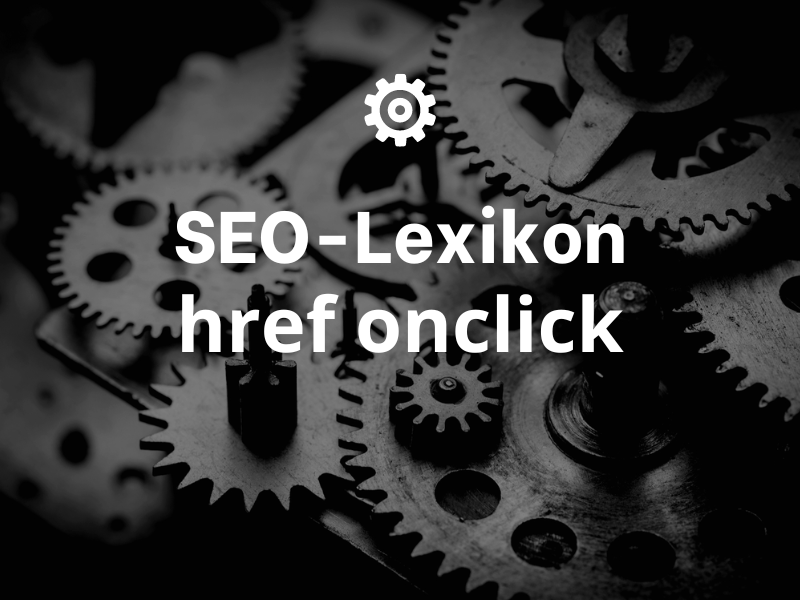Definition
Href onclick is an HTML method that allows developers to drive a page when a user clicks on an HTML element. It is an attribute attached to an HTML element that is activated when clicked.
So, to explain it simply: "href" in HTML stands for "Hyperlink-reference" and is what you normally use in a link tag (a tag) to refer to another page or resource. It looks something like this:
How href onclick works:
<a href="https://beispiel.de">Visit example.com</a>Now, when you bring "onclick" into play, you add a JavaScript-function, which is executed as soon as someone clicks on the link. It will look like this:
<a href="https://beispiel.de" onclick="meineFunktion();">Visit example.com</a>When someone clicks on this link, two things happen: First, the JavaScript-Funktion „meineFunktion()“ ausgeführt, und zweitens wird der Nutzer zur angegebenen URL forwarded. That sounds pretty cool, doesn't it?
But what if you do not immediately go to the specified URL weitergeleitet werden möchtest? Vielleicht möchtest du die Weiterleitung erst ausführen, nachdem die JavaScript-function is completed. Then you can replace the "href" with "javascript:void(0)“ ersetzen, um zu verhindern, dass der Link sofort zur angegebenen URL führt:
<a href="javascript:void(0)" onclick="meineFunktion();">Visit example.com</a>
Now the redirection will not be executed until you have specified this in your JavaScript-function, for example like this:
function myFunction() {
// Here you can write all the code that should happen before the redirect.
window.location.href = 'https://beispiel.de';
}
In diesem Fall würde der Nutzer erst zu „beispiel.de“ weitergeleitet, nachdem die „meineFunktion()“ komplett ausgeführt wurde. Zusammengefasst hilft dir „href“ mit „onclick“ dabei, die Weiterleitung zu einer URL with a JavaScript-function and thus have more control over the behavior of links.
Advantages
Href onclick provides developers with a flexible and cost-effective way to control a page. They don't have to write additional code to enable controlling the page, but can simply use the href attribute. It can also help users improve their experience on the page by making it easier to access content.
Disadvantages
A disadvantage of href onclick is that it is difficult for users to find the page they want to navigate to. Since it's just an attribute, the user has to click on a specific HTML element to get to the page. Also, it can be difficult to understand the code if it is too complex.
Use cases
- Form validation: You can
hrefandonclickto validate forms before they are submitted. For example, you can verify that all required fields have been filled in before the user is redirected to the confirmation page. - Pop-up window: You can work with
hrefandonclickopen a pop-up window when the user clicks on a link. For example, you can display an image gallery in a new window. - Confirmation messages: You can
hrefandonclickto display a confirmation message before the user performs an action. For example, you can ask if the user really wants to remove an item from the cart. - Cookie Handling: You can
hrefandonclickuse to Cookies or to read them out. For example, you can indicate to the user that your page is Cookies used and ask him for approval. - Tracking: You can
hrefandonclickto track clicks on links. For example, you can find out which links are clicked most often and optimize your page accordingly. - Dynamic content: You can
hrefandonclickto display dynamic content without having to reload the page. For example, you can display more information when the user clicks on a link. - Interactive elements: You can
hrefandonclickto control interactive elements on your page. For example, you can start or pause a slideshow when the user clicks on a link. - Asynchronous requests: You can
hrefandonclickto send asynchronous requests to the server and wait for the response to come back before forwarding the user. - Show and hide content: You can
hrefandonclickto show or hide certain content on your page. For example, you can expand or collapse a navigation when the user clicks on a link. - Multistep processes: You can
hrefandonclickto guide the user through multi-step processes without having to reload the page each time. For example, you can create a multi-step questionnaire in which the user clicks on "Next" to move on to the next question.
Through the combination of href and onclick you get a variety of ways to customize the behavior of links on your page to create a better user experience.
Conclusion
So, to summarize: href onclick is like a Swiss army knife for links. It gives you the power to extend the functionality of your links and customize them in creative and useful ways to meet the needs of your users. Instead of simply creating links that take the user from A to B, you can use href onclick enable multiple interactions and significantly improve the user experience on your website.
The combination of href and onclick allows you to create links with JavaScript-You can extend the functionality of your website to validate forms, display dynamic content, or track clicks. This allows you to improve the usability of your website and make it more effective.
Overall href onclick a powerful tool in your web developer arsenal that helps you realize the full potential of your links and provide a better user experience. It's like giving your car a turbo - it takes your links to a new level and gives them the ability to go far beyond what they were capable of before. So, go ahead and try href onclick to see how it can help you make your website even better!


